Case Study: Apple’s Global Impact
Apple Inc. is a prime example of globalization in action. The company designs its products in the United States, sources components from multiple countries, and assembles them in China. Through its App Store, Apple enables developers worldwide to create and distribute applications, further integrating the global economy. However, Apple’s global reach also brings challenges, such as price variations due to different tax structures, labor rights concerns in manufacturing countries, and regulatory issues in various markets. This case illustrates how globalization can both create opportunities and present obstacles for multinational corporations.
1.1 Understanding International Business

International business refers to commercial transactions that cross national borders. These transactions include exports, which are goods and services sold abroad, and imports, which are goods and services purchased from other countries. Companies engage in international business to expand their markets, reduce costs, and access resources unavailable in their home countries

A multinational corporation (MNC) is a business that has direct investments in multiple countries. MNCs operate globally by establishing subsidiaries, manufacturing facilities, and marketing networks across different regions. In contrast, a born global firm is a company that adopts an international approach from its inception, entering foreign markets early in its growth
1.2 What is Globalization?

Globalization is the process that connects economies, cultures, and markets worldwide. It influences various aspects of society, including business, technology, politics, and culture. The globalization of markets refers to the convergence of buyer preferences across different countries. Companies such as Apple, Nike, and Coca-Cola sell standardized products worldwide, benefiting from economies of scale and brand recognition. The benefits of market globalization include reduced marketing costs, as standardized marketing strategies can be used worldwide, and the ability to create new market opportunities, particularly in emerging economies such as China. Additionally, globalization helps level uneven income streams, allowing companies to maintain revenue stability by selling seasonal products in different hemispheres.
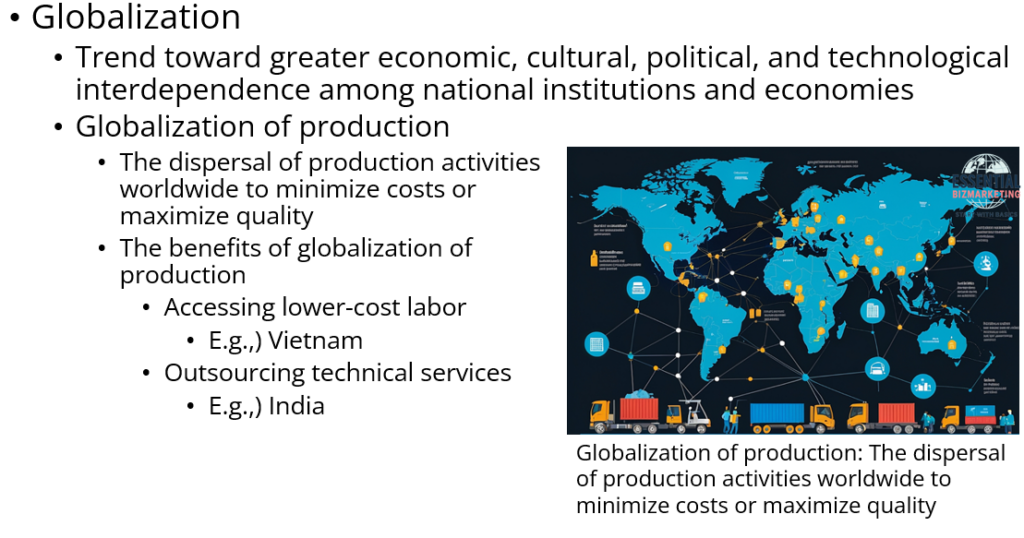
The globalization of production refers to the dispersal of production activities worldwide to minimize costs or maximize quality. Companies leverage this by accessing lower-cost labor in countries such as Vietnam and outsourcing technical services, such as IT development, to nations like India. A well-known example is Boeing, which sources aircraft components from multiple countries, integrating specialized expertise to ensure efficiency and cost-effectiveness.
1.3 What Drives Globalization?
Globalization is primarily driven by two major factors: the reduction of trade barriers and technological advancements.
Falling Barriers to Trade and Investment

Organizations like the World Trade Organization (WTO) and trade agreements such as the United States-Mexico-Canada Agreement (USMCA) have facilitated international trade by reducing tariffs and quotas. Before WTO, the General Agreement on Tariffs and Trade (GATT) played a crucial role in promoting international trade by reducing trade restrictions, but it lacked enforcement power. The WTO was established to replace GATT, providing a more structured and enforceable framework for global trade. Additionally, other international organizations such as the World Bank and the International Monetary Fund (IMF) contribute to global economic stability.
Technological Innovation
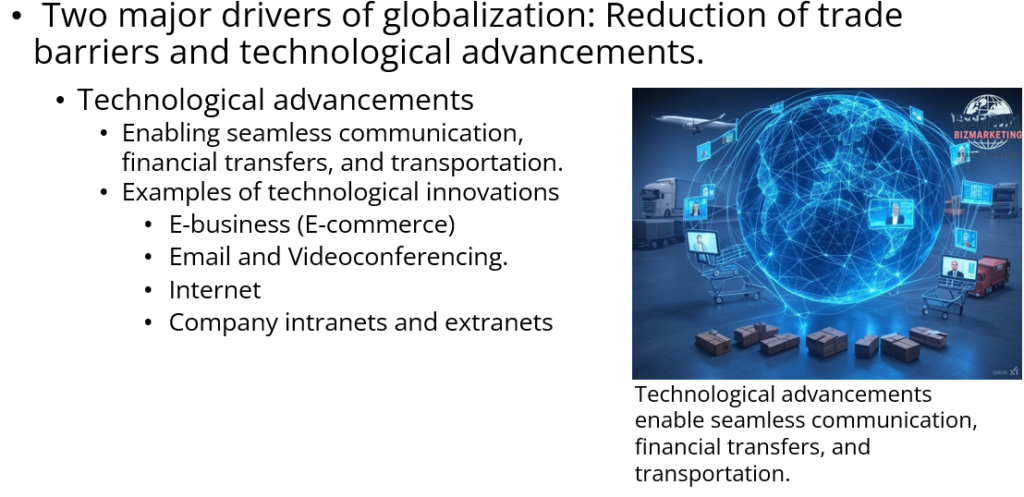
At the same time, technological advancements such as the internet, digital platforms, and logistics improvements have made global transactions more efficient by enabling seamless communication, financial transfers, and transportation. The growth of e-commerce, videoconferencing, company intranets, and advanced transportation technologies has further accelerated globalization, making international business operations smoother and more cost-effective.
1.4 The Debate on Globalization
Globalization is widely debated, with supporters and critics presenting different viewpoints.
Against Globalization

Critics argue that globalization eliminates jobs in developed nations by shifting manufacturing to lower-cost countries. They claim that outsourcing results in a loss of well-paying industrial jobs, forcing workers to accept lower wages in alternative employment. Additionally, globalization can exploit workers in developing nations, as multinational corporations often seek the lowest labor costs, sometimes at the expense of fair wages and working conditions.
For Globalization
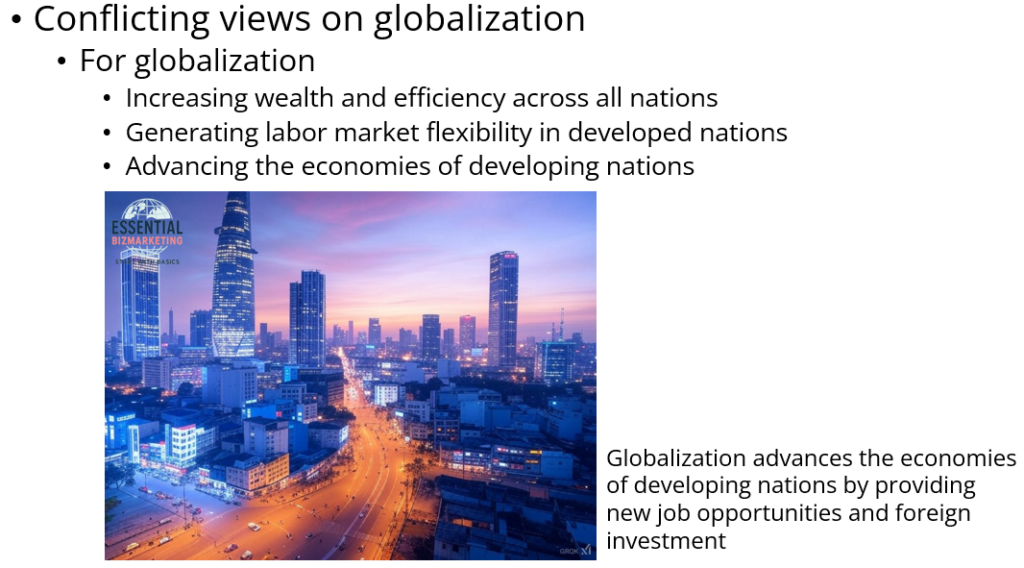
Supporters counter that globalization increases wealth and efficiency across all nations by promoting economic interdependence and competition. It also generates labor market flexibility in developed nations, allowing workers to shift between industries more easily, and advances the economies of developing nations by providing new job opportunities and foreign investment.
1.5. Debate on Income Inequality
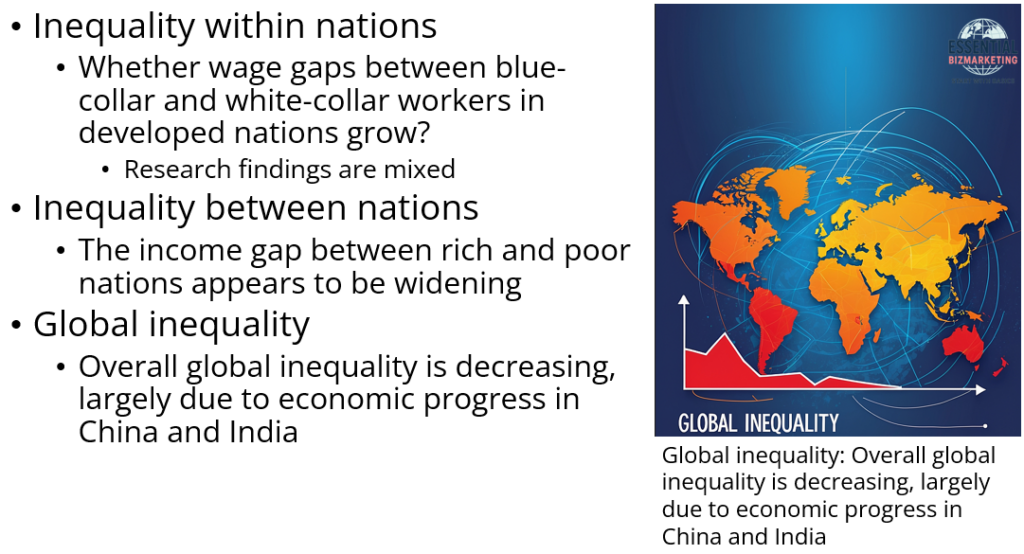
Inequality within nations
There is ongoing debate about whether globalization increases income inequality within countries. Some argue that wage gaps between blue-collar and white-collar workers in developed nations have widened as multinational corporations relocate production to low-wage countries. However, research findings on this issue are mixed. While some studies suggest that globalization exacerbates income disparities, others indicate that developing nations tend to experience overall income growth as they increase trade openness. Furthermore, poverty should be assessed through a multidimensional approach, which considers factors beyond income, such as health, education, and access to basic services.
Inequality between nations
At first glance, the income gap between wealthy and poor nations appears to be widening. However, globalization’s impact is not uniform across all countries. Nations such as China and India, which have actively embraced globalization, have successfully reduced their income gap with developed economies by fostering trade and investment. In contrast, many African nations continue to experience relatively slower economic growth, widening the disparity between them and high-income countries.
Global Inequality
Despite concerns about national and regional disparities, global inequality has been decreasing overall. This trend is largely driven by the economic progress of China and India, which have lifted millions out of poverty through sustained growth and globalization-driven reforms. According to the World Bank, the percentage of people living in extreme poverty (less than $1.90 per day) declined from 42% in 1981 to just 11% in 2013. However, significant challenges remain, particularly in Africa, which still accounts for more than half of the world’s poorest populations. In response, the United Nations has set an ambitious goal to reduce global poverty to 3% by 2030, requiring sustained international efforts in foreign aid, trade policies, and economic development initiatives.
1.5 Effects on Culture, Sovereignty, and the Environment

The impact of globalization on culture, sovereignty, and the environment is another widely discussed issue. Some argue that globalization leads to cultural homogenization, where global brands overshadow local traditions. Others claim that it allows cultural diversity to flourish by exposing people to different ideas and customs. Regarding sovereignty, critics claim that international trade agreements weaken national governments’ control, while supporters argue that globalization fosters cooperation and stability among nations. When it comes to the environment, globalization has increased industrialization and pollution, but it has also promoted global awareness of environmental issues, leading companies to adopt sustainable practices and eco-friendly policies.
1.6 Developing Global Business Skills
Understanding international business helps individuals develop essential skills such as critical thinking, communication, and adaptability. Critical thinking allows individuals to evaluate global markets and economic systems, while effective communication is necessary for navigating cross-cultural interactions in business. Adaptability is also a key skill for operating in diverse cultural and economic environments, ensuring that professionals can successfully work in different regions with varied regulations and business practices.
1.7 The Future of Globalization: Is Globalization Over?
In recent years, debates over the future of globalization have intensified. Some argue that the rise of protectionism, geopolitical tensions, and global crises like the COVID-19 pandemic signal the end of globalization. Others contend that globalization is merely evolving into a new form, shaped by technological advancements and shifting economic interdependencies.
The Slowdown and Transformation of Globalization
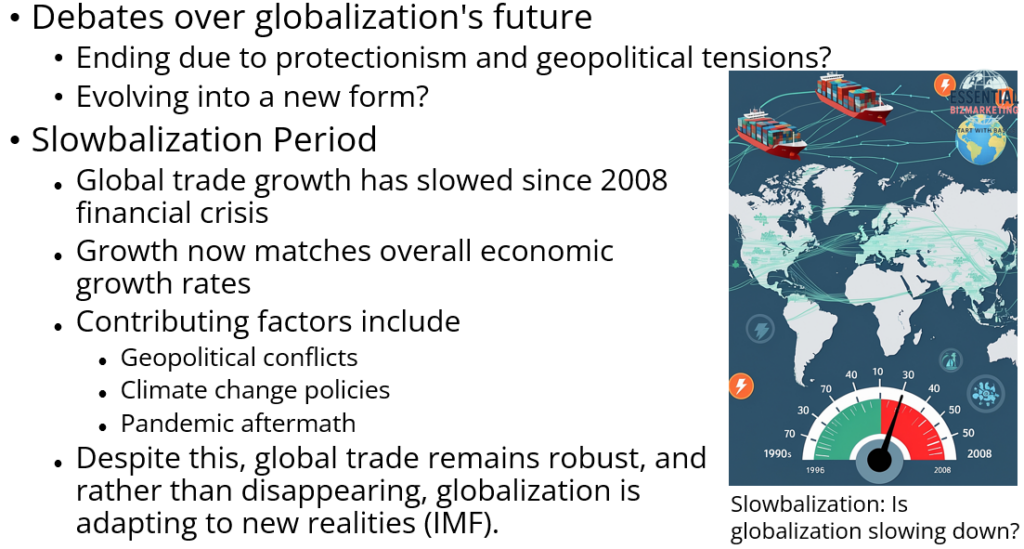
From the 1990s to the 2008 financial crisis, the world experienced rapid globalization. However, since then, global trade growth has slowed to levels closer to overall economic growth, a phenomenon referred to as “slowbalization.” This slowdown is attributed to factors such as geopolitical conflicts, climate change policies, and the aftermath of the pandemic. Despite this, global trade remains robust, and rather than disappearing, globalization is adapting to new realities (IMF).
Geopolitical Tensions and Protectionism
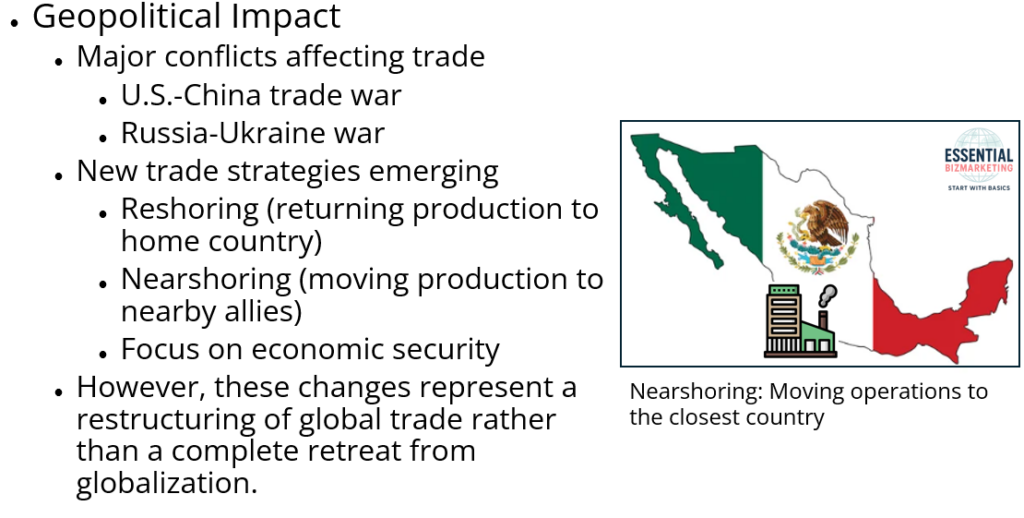
Geopolitical conflicts, such as the U.S.-China trade war and the Russia-Ukraine war, have fueled protectionist policies. Countries are prioritizing economic security by reshoring industries and reducing dependence on global supply chains. This shift has led to trends like “reshoring” (bringing production back home) and “nearshoring” (moving production to geographically closer allies). However, these changes represent a restructuring of global trade rather than a complete retreat from globalization (Financial Times).
Technology and Economic Interdependence
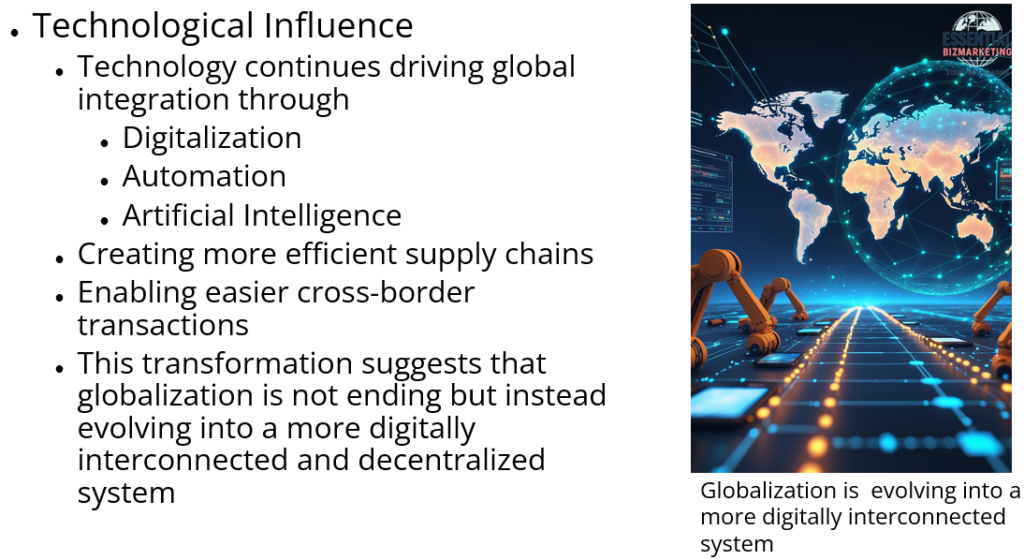
Technological advancements continue to drive globalization by reducing barriers to international collaboration. Digitalization, automation, and artificial intelligence (AI) are reshaping global trade by making supply chains more efficient and enabling seamless cross-border transactions. This transformation suggests that globalization is not ending but instead evolving into a more digitally interconnected and decentralized system (Project Syndicate).
Key Takeaway
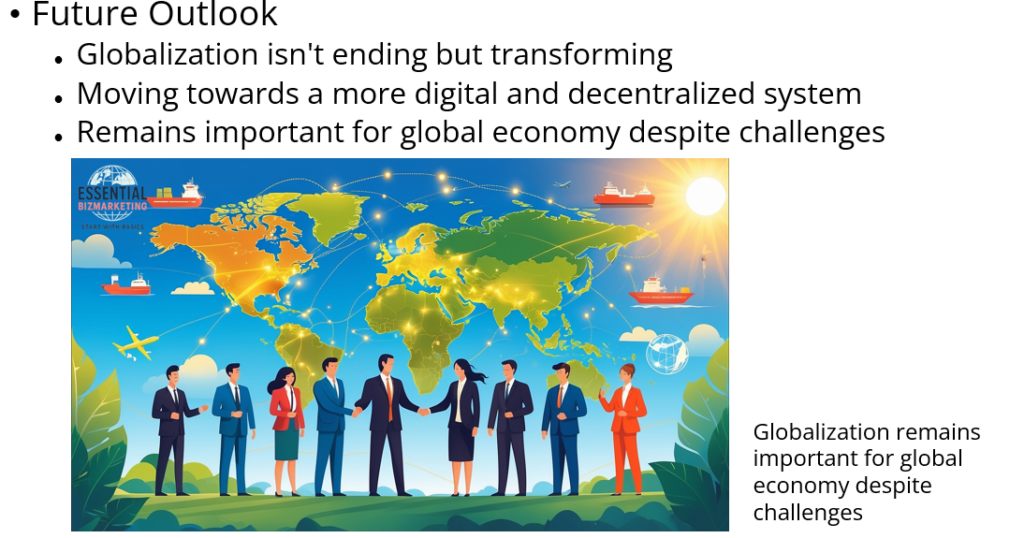
While globalization faces significant challenges, including rising protectionism and geopolitical conflicts, it is not coming to an end. Instead, it is undergoing a structural transformation, influenced by technological progress and changing economic policies. Countries and businesses are adapting to these shifts, ensuring that globalization remains a key driver of the global economy, albeit in a new and evolving form.
1.8 Conclusion
Globalization continues to shape the modern business landscape, offering both opportunities and challenges. While it has contributed to economic growth and innovation, it has also sparked debates on its social and environmental impact. By studying international business, individuals can better understand how to navigate this complex global economy and develop the skills needed for success in a rapidly changing world
Related videos
- Globalization Overview
- Apple’s Global Supply Chain
- Trade Agreements and Globalization
- The Debate on Globalization
- The Future of Globalization
📚 References
Wild, J. J., & Wild, K. L. (2019). International business: The challenges of globalization (9th ed.). Pearson.
📁 Start exploring the Blog
📘 Or learn more About this site
🧵 Or follow along on X (Twitter)
🔎 Looking for sharp perspectives on global trade and markets?
I recommend @GONOGO_Korea as a resource I trust and regularly learn from.
